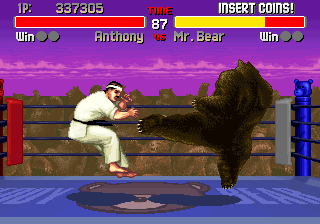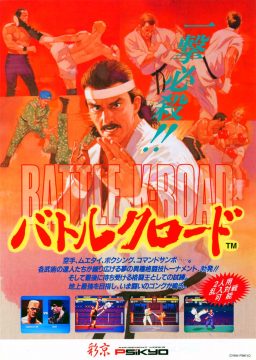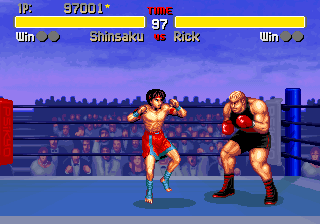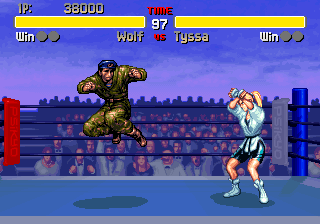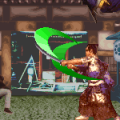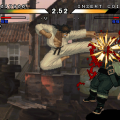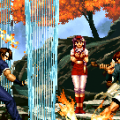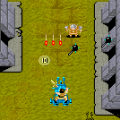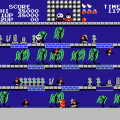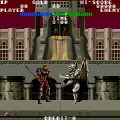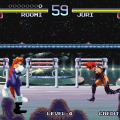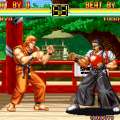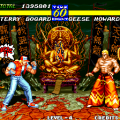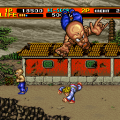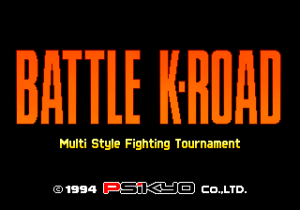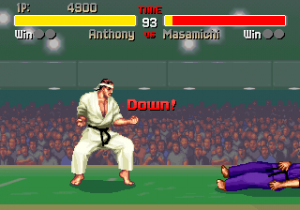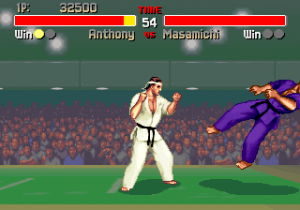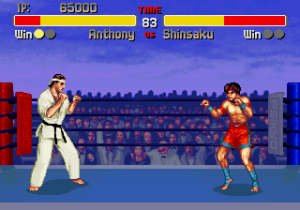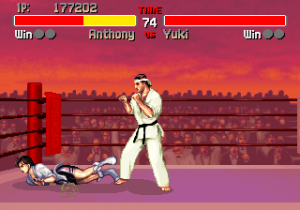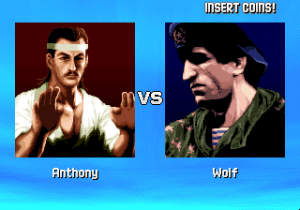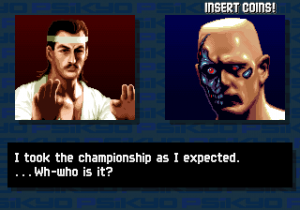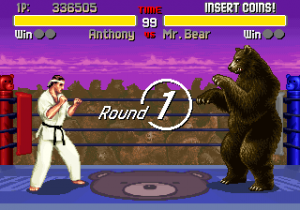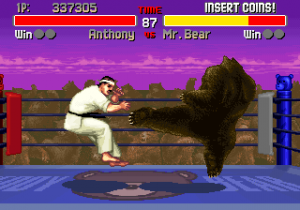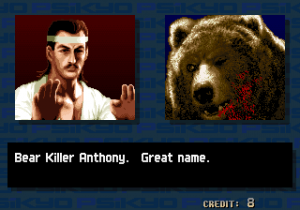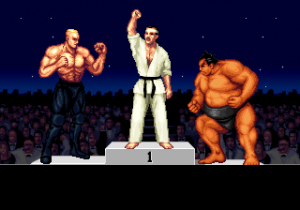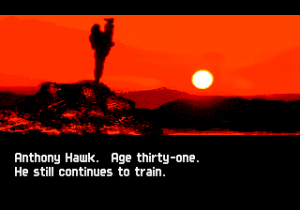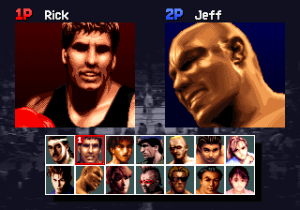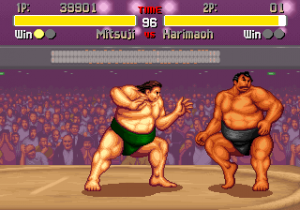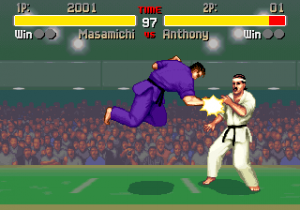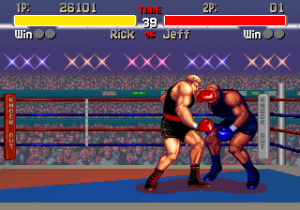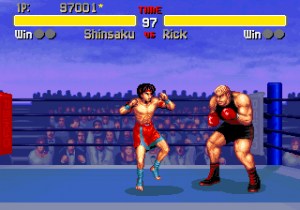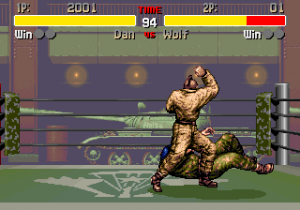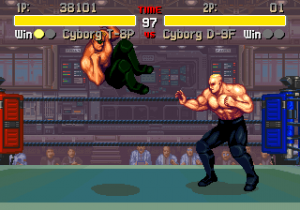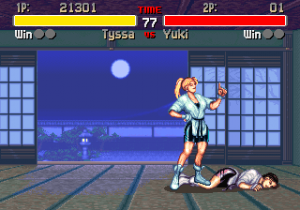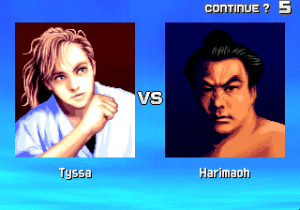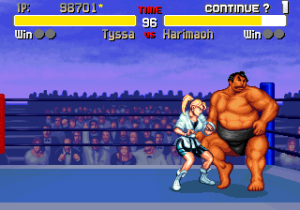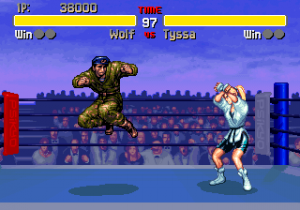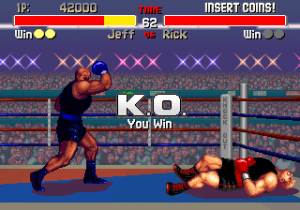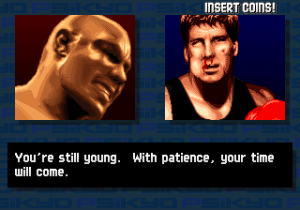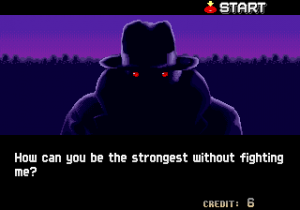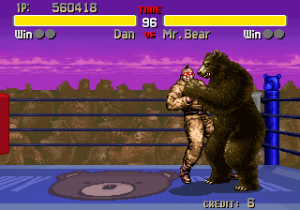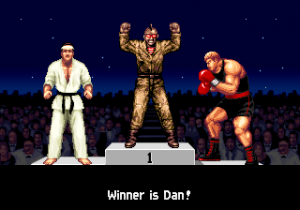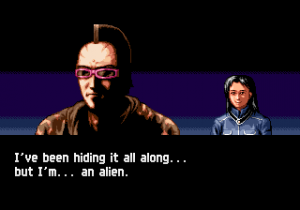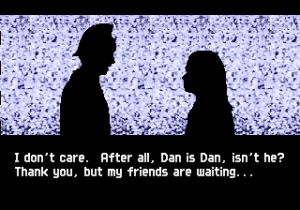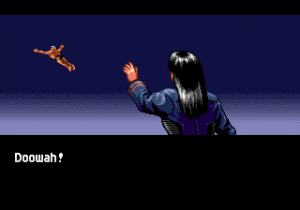While Psikyo was primarily heralded as a company who made solid and/or quirky shoot-em-up games, they tried their hand at a genre which was the forefront of the 1990s arcade scene: fighting games. Nearly every company that dabbled in arcade games produced at least one fighter to capitalize on the popularity of the genre, but none manage to topple Capcom, SNK, or Midway. Capcom’s Street Fighter II put fighters on the map, and they would build upon SF2‘s successes with Darkstalkers and X-Men: Children of the Atom. SNK was their major competition thanks to the likes of Fatal Fury, Art of Fighting, Samurai Shodown, and their flagship King of Fighters series. Most efforts to match Capcom and SNK’s success fell flat, but the only company to come close to their level of fame was Midway, who gained notoriety for their controversial Mortal Kombat series, which was better known for its insane levels of violence than its gameplay mechanics.
The contributions of several other big name companies did not quite pass muster. The often-great Konami had a rare dud in the painfully mediocre Martial Champion. Taito’s Kaiser Knuckle is only ever remembered for its hyper-cheap M. Bison rip-off of a final boss. And the less said about Strata’s Time Killers, the better. The relatively obscure Psikyo, known for shooters such as Sengoku Ace, Strikers 1945 and Gunbird, felt the need to claim their slice of the fighter pie with Battle K-Road and later, Daraku Tenshi / The Fallen Angels. Neither of them made much of an impact in arcades or for fighters in general, but they nevertheless warrant an examination for different reasons: a muddled mess of a pseudo-realistic game for the former and an interesting-yet-rushed concept for the latter.
When 2D fighters were gaining severe fame in the early nineties, Sega and Namco also put up their dukes with Virtua Fighter and Tekken, the two foremost 3D fighting games of the time. 2D fighters offered ridiculous characters with fantastical fighting styles, where combatants would jump 20 feet into the air, fire harmful projectiles out of nowhere, and throw their opponents from one edge of the battlefield to the other. In contrast, 3D fighters went for more realistic environments and contestants, accommodating the extra dimension with a considerably more authentic experience closer (but not absolutely akin) to real-life martial arts tournaments. Battle K-Road, ostensibly based off of a real-life fighting championship called the “K-Road Tournament,” (with actual images of tournaments in the attract intro) is an attempted fusion of the two primary fighter gameplay styles, converting a 3D feel into a 2D plane. It’s also feasible that Battle K-Road is a return to the form of early fighters before Street Fighter II revolutionized the genre, such as Karate Champ, International Karate, and so forth. The result of such a bold venture has turned up… admirable, but flawed results.
Battle K-Road is a very weird game. It’s the magnitude of how painfully blasé it is that warrants its remembrance. For example, fourteen characters are available in the roster, which was a decent selection for the time, or so it seems. On closer inspection, only half of the characters are actually original, while the other half retains similar fighting styles. Ostensibly, it seems they wanted to circumvent the potential problem of players being unable to select the same character in any given fight if they so desired, but why not just do what every other fighting game at the time was doing and create an alternate color palette for everyone? They instead put in unnecessary effort to give a head swapped version of the base seven characters. There may be one or two moves different between the two characters who share one combat style, but it’s just extravagant and kind of a cheat to falsely advertise a roster that’s only half as large as what it seems.
Anyway, the roster in question is rather generic, infested with plain and typical builds for straightforward fighting styles. Perhaps it’s not fair to chide the character selection for being boring, as they’re deliberately supposed to abide by real fighting styles: karate, boxing, sumo and so forth. It’s just weird to see characters that might fit better in Virtua Fighterthan a 2D-style fighter, and some of them ‘are’ notable in some way, even if for the wrong reasons.
Characters
Anthony Hawk & Masamichi Ohyama
Every fighting game needs a guy in a karate gi, often known as a “shoto,” and having moves similar to Ryu and Ken from Street Fighter II. However, there are no special tricks under either of these guys’ sleeves, just good old-fashioned non-fireball karate. Anthony has to be the shadiest karate practitioner ever in a game, what with his mullet and goofy mustache. Masamichi looks more typical of what you’d expect from a karate hero, and he is ergo completely unremarkable.
Rick Simpson & Jeff Howard
The requisite boxers whose ‘kicks’ are really just different punches. Seemingly based on real boxers, Rick looks a tad like Tommy Morrison, whom you probably remember best from the abysmal Rocky V. Jeff is kind of like George Foreman, back before he marketed his own line of grills. Whatever the case, they’re nowhere near as prolific as Balrog, Steve Fox, or what have you. However, they are arguably the most powerful characters alongside the cyborgs.
Shinsaku Maekawa & John Anderson
Yet another conventional fighting game archetype in the form of Muay Thai kick boxers. There’s not really much to be said about them other than how plain they are, even for this stupid roster. Seriously, John Anderson has to be the most vanilla name ever for a fighting game character. Shinsaku is a fine name for a fighter (albeit maybe for karate or judo as opposed to Muay Thai), but John Anderson? What is he, accountant by day, subpar kick boxer at night?!
Wolf & Dan
These soldiers are experts in Combat Sambo, though only Wolf really looks like an actual soldier, further complimented by his Sylvester Stallone-infringing facial profile. Dan looks more like a street punk who grabbed discount army garb from the local thrift store. His bizarre appearance may owe to the fact that he’s a space alien. No, really.
Cyborg D-9F & Cyborg T-8P
Yes, cyborgs very heavily inspired by James Cameron, with one resembling a bulked-up blonde Robert Patrick and the other looking like Ahnuld. Somewhat unsurprisingly, these uberhumans are the best characters in the game, due to their insane power and reach, and their speed isn’t too poor either. That’s what happens when you put FREAKING CYBORGS in a game where almost every other contestant is a boring inferior human.
Mitsuji Tanimachi and Harimaoh
Sumo wrestlers. Big strong guys who slap, stomp, and throw their opponents around, yet another fighting character mold that certainly has not been innovated within the confines of this roster. They were made even plainer by the lack of flying head-butts and multiple palm thrusts that break the sound barrier. Edmund Honda could not be found for comment.
Tyssa Willing & Yuki Fujiwara
The necessary female fighters who use jujitsu and look like they’re ready for a day at the gym. Pertaining to archetype, they’re fast but not too strong, and their designs seem a bit more “anime,” compared to other more realistic character models. Compared to other fighting games, their assets aren’t particularly accentuated, which is refreshing.
These characters are complimented by some bizarre character portraits that look somewhere between sprite art and photorealistic images, tilting somewhat into the uncanny valley. The in-game sprites themselves are animated decently for the time and at least look like competent fighters, even though there’s nothing special about most of them, save for the weirdo alien Dan. Now as for how they play, they’re all supposed to be ‘realistic’ without any supernatural moves. But, as said before, the attempt to simulate “super real fighting” (as billed in the intro) comes off as ham-fisted. The actual mechanics are bog standard, though that’s not necessarily a fault against it as most fighters from the early half of the nineties didn’t innovate too much beyond Street Fighter II‘s basic layout. Here, you have three punches and kicks assigned to different strengths, and you can crouch, jump, and attack while crouching or jumping just like any other fighter. You can also grab and perform either a throw or a grapple attack if you hold forward and press either medium or hard punch, though the grab range is kind of short compared to other games. You can also block, but one weird quirk is that you can’t crouch and block at the same time; holding down/away on the stick causes you to block low while standing, which makes you more susceptible to standing high attacks than this game’s contemporaries. Plain stuff aside, the innovations that Psikyo’s non-shmup brings to the table are best left on the shelf.
The most visibly unique mechanic of Battle K-Road is its knockdown system, whereby combatants who take a particularly heavy blow subsequently slump or fall to the ground while “DOWN!” flashes across the center of the screen. The action stops when this happens and both fighters reset to the middle of the arena. This is how it works in several real fighting tournaments, but when translated to a video game, it just feels odd and jarring. Not even most 3D fighters reset positions, and they’re better off for it in order to keep the action fast and flowing. In contrast, Battle K-Road‘s pace feels artificially stilted and sluggish with this imposed ‘down’ crap. Your heavy punches and kicks are slow enough and feel riskier than they should. Even if a hard attack connects and is not blocked, they have so much recoil that your opponent can counter with a potentially stronger attack. Still, light and medium attacks deal pithy damage, but are stiff enough that they can’t really be used in combos, so there’s not too much point in using them, except to be defensive and attempt to prevent your enemy’s harder attacks.
You are better off using special attacks when you can, though specials are executed rather strangely and are universal for every character. You hold down on either the hard punch or kick for a second and release, and you see a different attack depending on whether you are not moving, holding forward, crouching, jumping, or grabbing, effectively giving each character a total of ten specials. There’s also a universal dash command by rolling the stick a quarter-circle forward. Yes, the dash technique is Ryu’s Hadoken motion, instead of tapping forward twice like every other fighter ever. Most specials are nothing fancy, just a harder punch or kick than usual, though a few moves are kind of impressive, like the buzz saw flip-kick from the karatekas, and the low multi-punch assault from the Muay Thai kick boxers. The special attacks are pretty much as advanced as it gets here; no super meters, no dodge rolls, no false roman cancels or what have you. This is fighting at its simplest, perhaps too simple for most people’s tastes.
Why even play Battle K-Road when you can enjoy any incarnation of Street Fighter, Fatal Fury, Tekken, and the like? It can actually be a somewhat fun game to play despite its white-bread approach to fighting, if for no other reason than it IS simple enough that anyone can get into it without really knowing what they’re doing. On top of that, this game’s just so bizarre that it at least deserves a look, if from no other standpoint than one of grim curiosity. You’ll see the occasional bit of oddness in a fight, like the sumo wrestlers being able to fly across the screen and slam into their opponent butt-first. The cyborgs make mechanical whirring noises after each knockdown, just in case you forgot they were cyborgs. Yuki’s punch-grab special (but not Tyssa’s) involves slapping her opponent repeatedly before she rolls under them and pokes them really hard in the butt to knock them out. The scant attempts to pump characterization into the cast via their win quotes are laughable and unorthodox. Jeff is ridiculously religious, Dan is apparently in love with everyone he fights and John wants to prove he’s better than his father, which is not so weird per se, but we don’t know anything else about these characters aside from their endings.
Oh, dear Lord, the endings. Not only are the endings bizarre, but the final challenge you must beat to get them is one of the weirdest dang things in all of gamedom. While the presence of cyborgs certainly fractures any illusion of realism this game struggles to maintain, all bets are off when the final boss reveals himself to be… a bear; Mr. Bear, to be specific. He’s really big, really mean, and can potentially kill you in about three attacks. He even utilizes the Shoryuken and Tatsumaki Senpuu Kyaku, as some of his specials. Mr. Bear is ridiculously overpowered, as expected from almost all fighting game bosses to ever exist, and it almost makes you wish you COULD throw fireballs just to keep him away. On a side note, this game came out the same year as the first Tekken, which featured Kuma, Heihachi’s pet bear, as Paul’s sub-boss, so who knows who ripped off who in this case, or even if either company knew what the other had in mind. Anyway, if you manage to beat this ursine monstrosity, you’ll be ‘treated’ to an utterly bizarre and nonsensical ending sequence in a cartoonish art style, unlike anything else seen in the game. Nearly all of these are completely whacked out and ridiculous. For example, Rick becomes a Hollywood movie star only to fail in his new career; Shinsaku’s mother threatens to paddle him for running off; Dan reveals himself as an alien and flies off in a speedo; Cyborg D-9F’s torso rockets off into orbit; and Yuki’s victory turns out to be a dream concocted by an extraterrestrial. It’s ALMOST worth beating Mr. Bear to try and see these, though “ALMOST” is certainly the key word in all caps.
So that’s Battle K-Road in a nutshell. One more thing to mention that’s actually quite good is the music. While there’s nothing great akin to SNK’s fantastically-composed fighters, there are some catchy tracks that at least bring a certain mood to the fight. The game’s intro is set to a badass energetic and driving track, which also just so happens to be the music for both cyborgs. The boxers and sumo wrestlers have some neat tunes as well, and everyone else’s music is tolerable at the very least. It’s a good thing Mr. Bear has a neat pseudo-Arabian rock track for his theme, as you WILL be hearing it many times over, if you have the tolerance to fight on to the end. Naturally, Battle K-Road is best enjoyed by two players, as the AI can be rather unscrupulous, but good luck finding another friend willing to play it with you. It’s not that Battle K-Road is a flagrantly bad game, as it’s certainly more tolerable than Tattoo Assassins or War Gods or what have you, but it somewhat fails in what it tries to do, even though it’s an admirable attempt at the least.
Links:
The Video Game Museum Page of Battle K-Road‘s ridiculous endings.
Gameroom Blitz and its page on Daraku Tenshi.
Unseen 64‘s examination of stuff cut from Daraku Tenshi.
Jul (message board with a forum on cult game items) and its page on DT featuring Snake’s sprite.
Detailed fan-page
